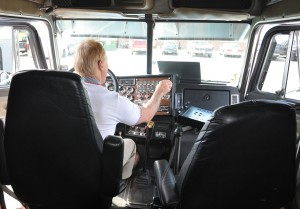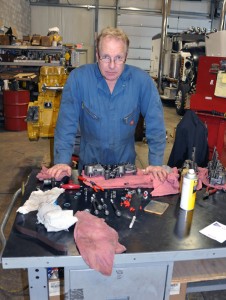 For many years, in the early part of my career, I was labeled as a “black sheep” in the trucking industry because many of my ideas were a bit ahead of their time. Eventually, the industry caught up with me and began to embrace my ideas about fuel efficiency and performance in diesel engines. Today, my company (Pittsburgh Power Inc.) is a well-respected business and I am very proud of that fact. But it wasn’t always easy – especially in those early days.
For many years, in the early part of my career, I was labeled as a “black sheep” in the trucking industry because many of my ideas were a bit ahead of their time. Eventually, the industry caught up with me and began to embrace my ideas about fuel efficiency and performance in diesel engines. Today, my company (Pittsburgh Power Inc.) is a well-respected business and I am very proud of that fact. But it wasn’t always easy – especially in those early days.
I got involved with the traffic management side of trucking when I was 19 years old. I also did some dispatching in those early days, and in the evenings I had a race car shop called Mallinson Performance (I built and raced Corvettes). Years later, the opportunity came along to get into the diesel engine side of the trucking industry and I was ready. Chuck Passmore wanted to move to Florida and start a new diesel shop, so I took over his small fuel injection shop in Pennsylvania and started working on diesel engines. I have always loved working with my hands, so I was able to thrive in this business.
Back in 1977, diesel engines were dirty, noisy and slow. In those days, a Small Cam NTC 350 was considered a “big hammer” and the Big Cam NTC Cummins was just coming out. In 1977, nobody in the industry had ever attempted to give extra fuel to a diesel engine, so I did. As I built relationships in the industry, I found that most owner operators were gear-heads like me. Owner operators coming out of Pittsburgh would often have a double load of steel coils on their trailers and the extra power I could give them was always welcomed.
I always figured, if I could drive a high performance Corvette as my every day car, why couldn’t an owner operator have a performance diesel engine in his everyday truck? Thinking this way got me labeled as a “black sheep” in the diesel engine industry. At first, this was not an easy path to follow. I was forbidden from belonging to some diesel engine organizations and was often told, “Oh, you’re that guy that turns up the engines – that’s going to come back and bite you. You can’t give these engines more power than what they were designed for.”
 Despite this negative attitude, many owner operators had faith in me and we never had the failures most in the industry said we would (we always installed turbo boost gauges and exhaust gas temperature gauges and taught the drivers how to use them). I remember when Cummins built the first NTC 444 and Caterpillar had introduced their 3406-B with 425 hp – both companies said they would never build a larger engine. By then, we were already building these engines with an additional 200 horsepower and NOT having any problems. So, if you find yourself getting labeled as a black sheep, so be it – stick to your guns, your dreams and your ambitions and don’t let anyone talk you out of what you truly believe! Now that the engine manufactures and other diesel engine shops have got into the performance side of things, I’m no longer considered to be the black sheep of the industry.
Despite this negative attitude, many owner operators had faith in me and we never had the failures most in the industry said we would (we always installed turbo boost gauges and exhaust gas temperature gauges and taught the drivers how to use them). I remember when Cummins built the first NTC 444 and Caterpillar had introduced their 3406-B with 425 hp – both companies said they would never build a larger engine. By then, we were already building these engines with an additional 200 horsepower and NOT having any problems. So, if you find yourself getting labeled as a black sheep, so be it – stick to your guns, your dreams and your ambitions and don’t let anyone talk you out of what you truly believe! Now that the engine manufactures and other diesel engine shops have got into the performance side of things, I’m no longer considered to be the black sheep of the industry.
Over the past several years, our goals at Pittsburgh Power have been focused primarily on improving fuel mileage, but we’ll never lose sight of what we’re known for – high performance. Now, when I say high performance I’m not talking about 1,000+ horsepower engines, I’m talking about engines in the 585 to 700 horsepower range. You have the option to have anything you want, but this power range is what guys usually want. We often hear, “I don’t want power, just fuel mileage.” Our response is always the same, “You won’t get great fuel mileage without power.” Since a semi truck burns most of its fuel when pulling a hill (and this country is NOT flat), the longer you spend on the hills, the more fuel you will burn.
We have found that a 12.7L Series 60 Detroit works best at 585 hp, and when we give an owner operator this kind of computer upgrade (from 430 hp to 585 hp) he NEVER wants to go back to stock. The DDEC-V 14L Series 60 loves to produce about 625 hp and can get great fuel mileage there (and you’ll never have to push the throttle to the floor). This also holds true for the Caterpillar and Cummins engines. The C-15 Cat, when upgraded from 585 hp to 700+ hp, is a pleasure to drive, and the Acert Cat (from 2005 through 2009), when properly upgraded, is my favorite engine to drive. These are what I would consider to be high performance engines.
Now if you want something for sled pulling or drag racing, that’s a different story. We can build a 14L Detroit to 1,950 hp at 2,800 rpm (2,800 rpm is currently the limit because once over that the rocker arms will snap). We are looking into having billet rocker arms made so the engine can pull up into the 3,000+ rpm range! Don’t even ask us for this kind of power if you’re taking this truck on the highway. These engines are not for the street and are ONLY for competition. But they sure are fun to build and drive!
Remember, enthusiasm will create the sustaining power of all great actions! And don’t be afraid to do things differently – it worked for me. If you have any comments or questions about fuel efficiency or performance, I can be reached at Pittsburgh Power in Saxonburg, PA at (724) 360-4080 or via e-mail at bruce@pittsburghpower.com.

15 Comments
i have a 1988 peterbilt 379 short hood and it has a 3406 b cat it has 320 hp and i would like to pick that up a bit .I pull loggs and most truck have 475hp to 500 how big can i go and what do i have to do
you are a master builder of all things that an owner operator holds deal and needs to compete in an overwhelming market. unlike your up and coming competitors like P D I you are a true gear head and not just a computer turd. best of luck to you and BIG thanks for keepin it real KEEP ON KEEPIN IT REAL BRO.
Thank you for the complement, Joey, I appreciate that. And at age 66 I do not have any plans yet of giving up. I do take some time off in the winter to snowmobile, my addiction! You know what is amazing, back in 1959 my father bought me a 3 speed English Racer bicycle, I was the only kid in the neighbor hood that had gears, we lived in a valley and I could pump up the hills when my friends had to push their bicycles. That is when I learned the value of gears.
Sincerely, Bruce
Was reading your story… I have a question… Got 350 big cam Cummins.. Needing a fuel pump is there anywhere I can find one.. Called Cummins dealer said they no longer make them.. Any help would be so thankful… Thanks again.
Got a 1979 big cam cummings, after rebuilding lower end, adjusting valves, and install injectors, I get a spark knock, have tried resetting all but still get spark knock any ideas Thanks
I had a Hot 1978 big cam 1 that had a fuel knock when you backed out of the fuel. everyone said i was hearing things but i knew i was hearing something. It about drove me crazy. I checked everything i could think of. Pulled the intake off and I noticed the intake looked like it had a little fuel in it. I had a pinhole in the air- fuel ratio diaphragm in the back of the fuel pump. When your manifold pressure came down it pushed fuel up the line into the intake.
I have a 60 series 12.7 500hp I would like more power. 650 to 700 what do I need to do..
I have a 1992 12.7 L 60 series says 450hp on the valve cover its in my Freightliner dump truck with pup . It’s okay but I still think it’s a turd . Looking into making some more power
Like you said like a reliable 585hp would be perfect what do I need all from you to get the job done?
I have a completely stock 350 big cam cummings. Formula type engine. Im just wondering how to turn a lil more fuel to it. Its a great engine solid as can be. I pull a flat bed most of the time. Any help i would really preciate it. Thx
Have a 45 ft motor home with 14 LTR 60 series 515 ho 1650 ft lbs. I put the ugly fix on it and mileage went from 6.5 to 7.2. Would like a bit more torque for hills. Allison good for 1950 ft lbs. can you fix?
I have a 1999 freightliner century 12.7 430hp getting 10.21mpg 90 day avg. Borghese warner 171702 turbo, turbo blanket, down pipe is heat wrapped, weed burner exhaust, crank shaft ballance, damper, ported exhaust manifold, 6×2 lift axle conversion on rig and forward lift axle on spread axle flatbed, micro blue wheel bearings, wheel covers, tire pressure monitor system, super single tires, fleet air filter, fass, ops. How can I get to 15mpg?
At what speed?
Also did the fass make a difference and was it worth it?
i have a 91 international i just purchased with a 444xt in it truck idles good but thats all it does step on throttle it just idles cant hear timing advance either on start up 75 PSI oil pressure on idle no oil in fuel tanks CPL 1280 any ideas where to start thx
hoe much to go thru my pump/injectors 444 cummins CPL 1280